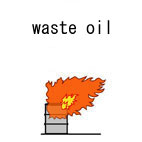| Case Name |
Fire caused due to an abnormal reaction at a high temperature of waste oil at the bottom of a waste oil tank at styrene recovery facilities |
| Pictograph |

|
| Date |
September 5, 1993 |
| Place |
Takaishi, Osaka, Japan |
| Location |
Chemical factory |
| Overview |
In a distillation column that recovered un-reacted styrene from a synthetic resin plant, an overhead condenser was plugged slightly. Pressure and temperature at the bottom rose. Polymerization was caused due to the high temperature at the bottom of a tank where waste oil was distilled. The operators who found the unusual condition started cooling the tank, but it was too late. Internal fluid spouted out, and caught fire. There was insufficient recognition in the company of the dangers related to a waste oil tank. The rupture accident was caused by insufficient control of temperature and pressure in the distillation column and the waste oil tank. |
| Incident |
At a synthetic resin plant, an un-reacted styrene monomer is recovered as a overhead product of a distillation column. The bottom waste oil of the distillation column reacted unusually in a waste oil tank, and a tank fire occurred. |
| Processing |
Storage |
| Process Flow |
Fig2.Unit process flow
|
| Substance |
Acrylonitrile, Fig3 |
| Ethylbenzene, Fig4 |
| Styrene, Fig5 |
| Waste oil |
| Type of Accident |
Rupture, fire |
| Sequence |
1. An operator discovered white vapor leaking from the vent pipe of a waste oil tank during routine patrol at the plant.
2. The tank was cooled using industrial water. Although there is no description in the document, the cooling coil of the tank might have been used.
3. The roof of the waste oil tank was damaged. The content fluid spouted, and caught fire. |
| Cause |
In a distillation column for recovering an un-reacted styrene monomer, an overhead condenser was plugged partially by a polymer of recovered styrene. As a result, temperature and pressure in the column rose, and waste oil with higher temperature than a design temperature (40 °C) flowed into the waste oil tank. Therefore, a polymerization reaction occurred in the tank. Temperature and pressure of the tank rose, and waste oil spouted out. It was considered that a fire was caused by a static electricity spark. The tank was cooled when operators found the abnormal status, but this was not effective. Feed materials sent to the recovery column were a liquid mixture of acrylonitrile, ethylbenzene, styrene, oligomer, and the bottom liquid was a liquid mixture of acrylonitrile, ethylbenzene, oligomer, etc. |
| Response |
Private fire fighters and public fire fighters turned out. |
| Countermeasures |
Review the work standard document. Improve the monitoring system. Reexamine similar facilities. |
| Knowledge Comment |
The waste oil has a complicated composition, and an unexpected reaction might occur if the temperature rises. The dangerous nature of a waste oil tank must be sufficiently recognized. |
| Background |
Inadequate management of operating conditions such as pressure and temperature seems to be basic causes. It is known that styrene polymerizes very easily. At the condenser overhead where styrene concentration is high, if styrene begins to polymerize and a polymer adheres to the tube, the adhered polymer would act as the nucleus, and a polymerization reaction would be accelerated, and the heat exchanger tubes would be easily plugged. General knowledge about the properties of styrene and plugging of the tube might be overlooked in operation management. The cooling coil of the tank might have been installed to protect against a high temperature. It is considered that cooling water should have been supplied to cool the tank at the beginning of September, as it was still hot. |
| Reason for Adding to DB |
Example of fire caused due to an abnormal reaction of distilled styrene at a high temperature at a recovery distillation tank |
| Scenario |
| Primary Scenario
|
Poor Value Perception, Poor Safety Awareness, Inadequate Risk Recognition, Organizational Problems, Poor Management, Slackness of Management, Insufficient Analysis or Research, Insufficient Practice, Lack of Imagination, Ignorance, Insufficient Knowledge, Insuficient Study and Experience, Planning and Design, Poor Planning, Poor Design, Bad Event, Chemical Phenomenon, Abnormal Reaction, Bad Event, Mechanical Event, Clogging, Bad Event, Chemical Phenomenon, Temperature Rise, Secondary Damage, External Damage, Rapture/Fire, Loss to Organization, Economic Loss
|
|
| Sources |
Fire and Disaster Management Agency, Fire caused by polymerization reaction in waste oil tank. Accident cases of dangerous materials. pp.128-129 (1993)
National dangerous material safe association, Fire in outdoor tank, 100 cases of accidents at dangerous material treating facilities. p.23 (1999).
|
| Physical Damage |
The roof of the tank was opened by rupture. The tank and attachment piping were damaged and burned out. Adjacent facilities for dangerous materials were damaged by fire. |
| Financial Cost |
¥ 8 million (Fire and Disaster Management Agency) |
| Multimedia Files |
Fig3.Chemical formula
|
|
Fig4.Chemical formula
|
|
Fig5.Chemical formula
|
| Field |
Chemicals and Plants
|
| Author |
KOSEKI, Hirosi (National Research Institute of Fire and Disaster)
TAMURA, Masamitsu (Center for Risk Management and Safety Sciences, Yokohama National University)
|
|